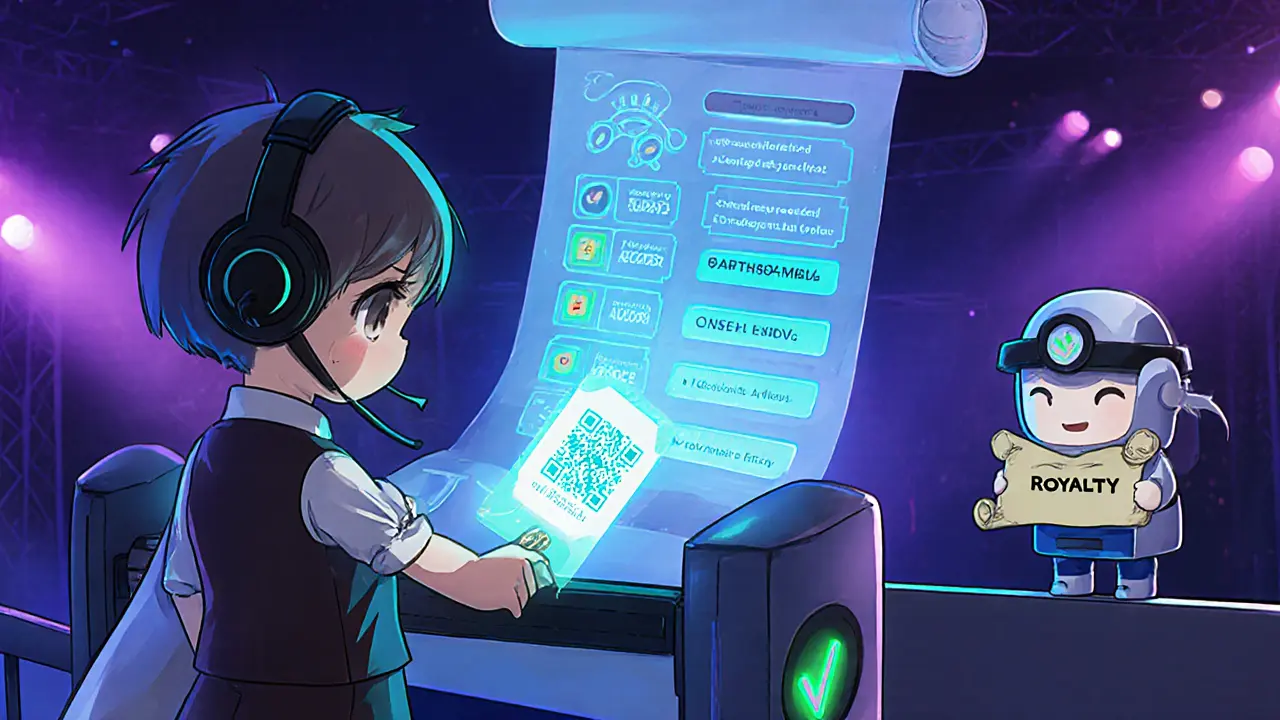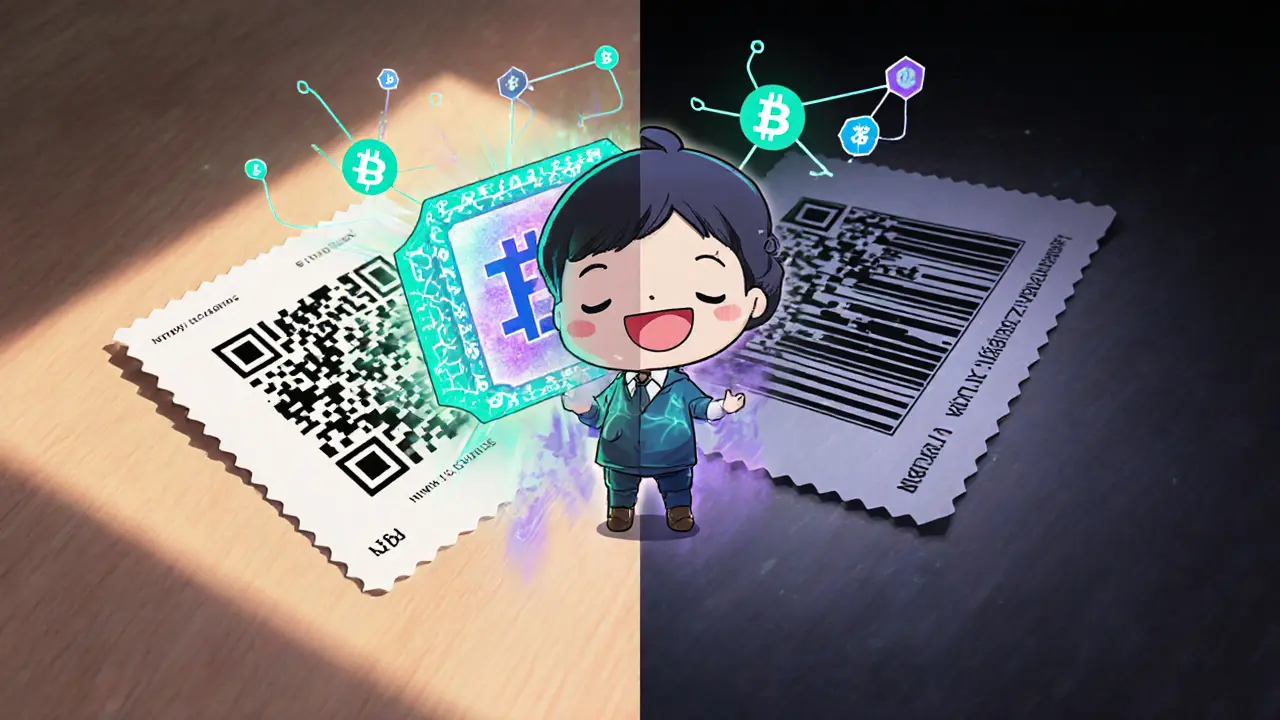NFT Ticket Verification Comparison Tool
This tool helps you understand how NFT tickets differ from traditional QR/Barcode tickets in terms of verification, security, and functionality.
- Immutable blockchain records
- Smart contract automation
- Real-time ownership verification
- Resale royalty enforcement
- Centralized databases vulnerable to hacks
- High duplication risk
- Limited resale control
- No transparency in ownership history
| Feature | Traditional QR/Barcode | NFT Ticket |
|---|---|---|
| Verification Source | Centralized database owned by ticket vendor | Decentralized blockchain ledger |
| Duplication Risk | High - codes can be printed or screenshot | Near-zero - each token is unique and immutable |
| Resale Control | Limited - often no royalty enforcement | Smart contracts can enforce royalties & resale caps |
| Scalping Prevention | Rare - rely on manual bans | Programmable limits (e.g., one ticket per wallet) |
| Ownership Transparency | Opaque - internal logs only | Public, auditable transaction history |
Blockchain-based verification offers several security advantages:
- Immutability: Once a ticket is recorded on the blockchain, it cannot be altered or deleted.
- Decentralization: No single point of failure makes it resistant to cyber attacks.
- Transparency: Anyone can verify the authenticity of a ticket at any time.
- Cryptography: Digital signatures ensure the ticket was issued by authorized parties.
In contrast, traditional systems depend on centralized databases that can be compromised or manipulated.
While NFT tickets offer superior security, there are practical challenges to consider:
Technical Challenges
- Transaction fees during peak times
- Wallet accessibility for non-tech users
- Performance bottlenecks with large-scale verification
- Privacy concerns around public ownership data
Solutions
- Use layer-2 solutions for cost efficiency
- Provide custodial wallets for ease of use
- Implement hybrid off-chain caching
- Mask personal information with pseudonyms
Ticket fraud costs the live‑event industry billions each year, and organizers are desperate for a solution that can actually stop counterfeit passes. NFT ticket verification promises exactly that by turning each ticket into a tamper‑proof digital asset you can check in seconds. Below you’ll learn how the technology works, why it beats QR codes, and what you need to do to roll it out at your next venue.
Key Takeaways
- Each NFT Ticket is a one‑of‑a‑kind token recorded on a blockchain, giving you an immutable proof of ownership.
- Verification happens by reading the token’s public address and confirming its status on the Blockchain a decentralized ledger where all transactions are permanently stored.
- Smart contracts on Ethereum the most widely used blockchain for NFTs, handling token creation and transfer can enforce resale royalties and scalping limits automatically.
- Venue staff need a scanning app that talks to the blockchain - tools like SeatlabNFT a platform that reads NFT metadata and verifies authenticity in real time are already in production.
- Challenges such as “used‑ticket” marking require a hybrid approach that combines on‑chain data with a lightweight off‑chain database.
How an NFT Ticket Is Created and Stored
Event organizers start by defining a Smart Contract self‑executing code that lives on the blockchain and governs the life‑cycle of each ticket. The contract lists essential attributes - event name, date, seat number, and a unique token ID. When a buyer purchases a ticket, the contract mints a new NFT Ticket and assigns it to the purchaser’s Digital Wallet software that holds private keys and can sign blockchain transactions address.
Because the token lives on a public ledger, anyone can query the token ID and see an unchangeable history: who created it, every transfer, and whether the contract has flagged it as “used”. This immutable record is the core of verification.
Verification Process on the Day of the Event
When a guest arrives, a staff member scans a QR code or NFC tag that encodes the token’s public address. The scanning app sends a read‑only request to the blockchain, retrieving the token’s current owner, its validity flag, and any attached Cryptographic Signature a digital proof that the token was signed by the contract creator. If the address matches the guest’s wallet and the “used” flag is false, the system flashes green and opens the gate.
If the token is already marked as used, the app alerts staff to a potential double‑use attempt. Some venues also write a tiny “entry” transaction back to the blockchain, updating the flag in real time; others keep a fast off‑chain cache for thousands of entries per minute to avoid network bottlenecks.
Why NFT Tickets Beat Traditional QR or Barcode Systems
| Aspect | QR/Barcode Ticket | NFT Ticket |
|---|---|---|
| Verification Source | Centralized database owned by ticket vendor | Decentralized blockchain ledger |
| Duplication Risk | High - codes can be printed or screenshot | Near‑zero - each token is unique and immutable |
| Resale Control | Limited - often no royalty enforcement | Smart contracts can enforce royalties & resale caps |
| Scalping Prevention | Rare - rely on manual bans | Programmable limits (e.g., one ticket per wallet) |
| Ownership Transparency | Opaque - internal logs only | Public, auditable transaction history |
The decentralized nature removes a single point of failure. Even if a hacker compromises the ticket vendor’s server, the blockchain copy remains untouchable.

Benefits Beyond Security
Secondary‑Market Revenue: Because the smart contract can stipulate a %‑based royalty, every resale automatically sends a slice back to the organizer. This turns ticket scalping into a potential income stream.
Personalized Experiences: Organizers can embed extra metadata - access to backstage lounges, exclusive merch drops, or dynamic pricing based on attendance‑time. Since the data lives on‑chain, it can be updated in real time without re‑issuing a new ticket.
Peer‑to‑Peer Transfers: Fans can sell or gift tickets directly through their wallets, eliminating middlemen and reducing fees.
Technical Challenges and How to Overcome Them
1. Marking a Ticket as Used
- Pure on‑chain writes are slow and costly at scale.
- Solution: Write a lightweight “used” flag to an off‑chain cache (e.g., Redis) that’s signed by the contract’s validator. Periodically batch‑update the blockchain for auditability.
2. Wallet Accessibility for Non‑Tech Users
- Many attendees don’t have crypto wallets.
- Solution: Provide custodial wallets managed by the ticket platform, or use email‑linked wallet addresses that the app can retrieve automatically.
3. Transaction Fees (Gas)
- Ethereum gas spikes can make minting pricey.
- Solution: Batch mint tickets, use layer‑2 solutions (Polygon, Optimism) or explore alternative EVM‑compatible chains with lower fees.
4. Privacy Concerns
- Public ownership data could expose attendee identities.
- Solution: Mask personal info with hash‑derived pseudonyms; only the contract owner can decrypt when needed.
Step‑by‑Step Guide to Implement NFT Ticket Verification
- Define Ticket Schema - decide which fields (event name, seat, tier, perks) go into the token metadata.
- Write the Smart Contract - include functions for mint, transfer, royalty payout, and a “markUsed” flag.
- Choose a Blockchain - Ethereum mainnet for visibility, or a layer‑2 for cost efficiency.
- Deploy the Contract - publish to the chosen network; record the contract address.Integrate a Wallet Provider - partner with MetaMask, WalletConnect, or a custodial solution for ticket buyers.
- Issue Tickets - mint NFTs and send them to buyers’ wallet addresses.
- Send a QR code that encodes the token ID and wallet address for quick scanning.
- Set Up Verification Hardware - use smartphones or dedicated scanners running a SeatlabNFT verification SDK that queries the blockchain and returns a pass/fail verdict SDK.
- Handle Entry - on a green verdict, optionally push a “used” transaction to the contract or update the off‑chain cache.
- Monitor and Audit - keep a log of all entry attempts; reconcile off‑chain flags with on‑chain state after the event.
Future Trends in NFT Ticket Authentication
Hybrid Scanning: Expect more venues to blend on‑chain verification with high‑speed QR readers, using edge‑computing devices that cache the latest blockchain state. This keeps the user experience snappy while retaining security.
Dynamic Pricing & Access: Smart contracts could automatically upgrade a ticket’s tier if the owner meets certain conditions (e.g., attends three events). Such “living tickets” keep fans engaged and provide new revenue hooks.
Interoperability Standards: The OpenTicket standard, currently in beta, aims to let different ticketing platforms speak the same NFT language, making resale across ecosystems frictionless.
Green Blockchain Solutions: As environmental concerns grow, many organizers are testing proof‑of‑stake chains that cut energy use by 99% compared to early Ethereum.
Frequently Asked Questions
Can I still use paper tickets alongside NFT tickets?
Yes. Many hybrid events issue paper tickets for guests without wallets while offering NFT tickets for the tech‑savvy crowd. The verification system simply checks whichever format is presented.
What happens if a smartphone battery dies at the gate?
Organizers can print a small backup QR code that encodes the same token ID. The scanner reads the code, looks up the address on the blockchain, and validates the ticket without needing the phone’s battery.
How are resale royalties enforced?
The smart contract includes a %‑based royalty clause. Every time the token changes ownership, the contract automatically transfers the royalty amount to the organizer’s wallet before completing the sale.
Is my personal data exposed on the blockchain?
Only the public wallet address and non‑identifying ticket metadata are visible. Personal details (name, email) are stored off‑chain and linked via a cryptographic hash, keeping privacy intact.
Do I need to pay gas fees each time I enter a venue?
Ideally no. Most venues use an off‑chain cache to mark tickets as used, avoiding a blockchain transaction at entry. Only the initial mint and any resale incur gas costs.




OLAOLUWAPO SANDA
March 6, 2025 AT 04:38These NFT tickets are just a waste of money, Africa doesn't need them.
Alex Yepes
March 15, 2025 AT 19:24While the technical merits of blockchain are evident, the practical implementation for mass events must consider user experience. A well‑structured guide can bridge the knowledge gap, encouraging adoption without overwhelming newcomers. Moreover, establishing clear standards will foster trust among stakeholders, from organizers to attendees. By emphasizing both security and accessibility, the industry can move forward confidently.
Sumedha Nag
March 25, 2025 AT 10:10Honestly, all this hype about NFT tickets feels like another marketing gimmick. I’d rather have a simple paper stub that works than worry about wallets and gas fees.
Holly Harrar
April 4, 2025 AT 00:56Hey folks, just wanted to add a quick note – the smart contract part is actually pretty straight forward, if you use a platform like SeatlabNFT. You’ll notice the minting cost can be cut by batch processing, and the off‑chain cache helps keep entry speed fast. Also, don’t forget to test the “used” flag on a testnet first – it saves a lot of headaches later. Hope that helps!
Vijay Kumar
April 13, 2025 AT 15:43Great article! I think the hybrid approach mentioned-using both on‑chain data and a fast off‑chain cache-is the sweet spot. It keeps security high while still delivering the speed fans expect at the gate. Plus, offering custodial wallets can lower the barrier for non‑techy users, which is essential for large events.
Edgardo Rodriguez
April 23, 2025 AT 06:29When we consider the nature of verification, we must ask: what is the essence of authenticity? Is it merely a record, or is it a trustless guarantee? The blockchain, by virtue of its immutable ledger, offers a promise that no single entity can rewrite, and this is a profound shift from centralized databases, which are vulnerable to single points of failure. Moreover, the public audibility of each transaction transforms the ticket from a private token into a communal artifact, observable by any participant in the network. This transparency, however, does not come without cost; the computational overhead of consensus mechanisms can introduce latency, especially under peak load, a factor that event organizers must mitigate through layer‑2 solutions. In practice, the marriage of on‑chain verification with off‑chain caching yields a hybrid architecture that capitalizes on the strengths of both worlds: immutable proof on the blockchain, rapid lookup via a cache. The smart contract itself, acting as both creator and enforcer, can embed royalty logic, resale caps, and usage flags, thereby automating enforcement that would otherwise require manual oversight. Yet, the philosophical implication runs deeper: by tokenizing attendance, we invite a reevaluation of ownership, transforming a right to occupy space into a tradable digital asset. This challenges traditional notions of fandom, where the experience, not the token, was paramount. As we move forward, we must balance the allure of monetization with the integrity of the attendee experience, ensuring that the technology serves the people, not the other way around.
mudassir khan
May 2, 2025 AT 21:15The so‑called "security" of NFTs is overstated; gas fees alone can make entry prohibitive, and the reliance on blockchain scalability is, frankly, a pipe dream. While the guide mentions layer‑2 solutions, it glosses over the fact that many venues lack the infrastructure to support them, rendering the entire premise impractical.
Bianca Giagante
May 12, 2025 AT 12:01I see both sides here; blockchain does provide undeniable transparency, yet we must acknowledge the accessibility challenges for everyday users. Perhaps a hybrid model, as suggested, could bridge the gap without sacrificing security.
Andrew Else
May 22, 2025 AT 02:47Oh great, another tech fad that will probably die before the next season.
Susan Brindle Kerr
May 31, 2025 AT 17:33Honestly, the drama of turning a simple ticket into a flashy NFT is just... over the top. Who needs all that sparkle?
Jared Carline
June 10, 2025 AT 08:20While the article is thorough, I remain skeptical about the feasibility of enforcing resale royalties across borders; international law does not yet recognize smart contract jurisdiction, making such mechanisms largely symbolic.
raghavan veera
June 19, 2025 AT 23:06Thinking about tickets as digital contracts makes me wonder: are we just shifting the old power dynamics onto a new platform? If the same entities control the smart contracts, does anything really change?
Danielle Thompson
June 29, 2025 AT 13:52Nice write‑up! 👍 Keep it up!
Eric Levesque
July 9, 2025 AT 04:38Enough of this tech talk, just give us tickets that work.